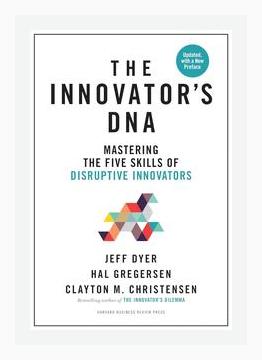Business StrategyCompetitive Strategy
The Innovator’s DNA: Mastering the Five Skills of Disruptive Innovators
By Jeff Dyer, Hal Gregersen, and Clayton M. Christensen
Introduction
“The Innovator’s DNA: Mastering the Five Skills of Disruptive Innovators” explores the traits and behaviors that drive innovation and how these can be cultivated to foster disruptive innovation within individuals and organizations. The authors Jeff Dyer, Hal Gregersen, and Clayton M. Christensen identify five key skills: Associating, Questioning, Observing, Networking, and Experimenting. Through detailed analysis and concrete examples, the book not only illustrates these skills but also provides actionable steps to integrate them into one’s daily practice.
Associating
Key Concept:
Associating or “connecting the dots” involves linking ideas that are seemingly unrelated to create new and innovative solutions. It rests on the premise that creativity often stems from combining existing concepts in novel ways.
Examples:
– Steve Jobs and the iPod: Jobs linked different fields—engineering, design, and music—to create the iPod, which revolutionized the music industry.
– Jeff Bezos and Amazon’s Marketplace: Bezos combined the traditional retail model with the digital platform to create a new way of shopping that offers vast product selection and convenience.
Actionable Step:
– Mind Mapping: Regularly practice creating mind maps to connect disparate ideas, visualize relationships, and foster creative thinking.
Questioning
Key Concept:
Innovative questioning involves challenging the status quo by asking “what if” and “why not” questions. This helps uncover limitations and leads to novel approaches and solutions.
Examples:
– Ratan Tata and the Tata Nano: Tata questioned why cars couldn’t be affordable for the average Indian family, leading to the creation of the Tata Nano, a low-cost vehicle.
– Reed Hastings and Netflix: Hastings asked why late fees were necessary, which led to the innovative subscription model of Netflix, eliminating fines and enhancing customer satisfaction.
Actionable Step:
– The Five Whys Technique: Practice asking “why” five times to drill down into the root cause of a problem, encouraging deeper understanding and innovative thinking.
Observing
Key Concept:
Observation involves scrutinizing behaviors, activities, and trends to glean insights that others might miss. Innovators often gain inspiration by closely watching people’s interactions, challenges, and solutions.
Examples:
– Howard Schultz and Starbucks: Schultz observed the vibrant coffee bar culture in Italy and adapted it to American consumer habits, transforming Starbucks into a global coffeehouse chain.
– Pierre Omidyar and eBay: Observing how people enjoyed trading collectibles, Omidyar created eBay, a platform capitalizing on the excitement and community aspect of auctions.
Actionable Step:
– Customer Shadowing: Spend time observing customers in their natural environments, noting problems and unmet needs to better inform product development.
Networking
Key Concept:
Innovative networking means interacting with a broad range of individuals to gather diverse perspectives and knowledge. This cross-pollination of ideas is crucial for innovation.
Examples:
– Alice Waters and Chez Panisse: Waters drew inspiration from engaging with local farmers, chefs, and food enthusiasts, which helped her pioneer the farm-to-table movement at Chez Panisse.
– Tim Berners-Lee and the World Wide Web: Berners-Lee’s diverse professional network across various fields helped in conceptualizing and realizing the World Wide Web.
Actionable Step:
– Diverse Networking: Make a conscious effort to attend events, seminars, and industry conferences outside your immediate field to gain varied insights and perspectives.
Experimenting
Key Concept:
Experimenting involves actively trying out ideas through pilots, prototypes, and trials to learn from results and iterate. Experimentation fuels innovation by turning abstract concepts into concrete solutions.
Examples:
– Thomas Edison and the Light Bulb: Edison’s iterative experiments with different filament materials eventually led to the successful and commercially viable light bulb.
– Amazon Web Services: Amazon experimented with its own web infrastructure to meet its growing needs, which eventually led to the creation of Amazon Web Services, revolutionizing cloud computing.
Actionable Step:
– Rapid Prototyping: Develop and test small-scale versions of ideas quickly and inexpensively to gather feedback and refine the concepts.
Integration into Personal and Organizational Practice
Personal Development:
– Dedicate Time to Creativity: Allocate specific time slots in your schedule for creative activities like brainstorming, reading diverse materials, and reflecting.
– Build a Learning Routine: Regularly engage in activities that enhance associative thinking, such as reading books from different genres, learning new skills, and participating in cultural experiences.
Organizational Culture:
– Create Innovation Teams: Form diverse teams within the organization to encourage cross-discipline interaction and idea generation.
– Encourage Open Dialogues: Foster an environment where questioning is welcomed and valued, promoting a culture of continuous improvement and innovation.
– Establish R&D Programs: Invest in dedicated research and development initiatives to continuously experiment with new ideas and technologies.
– Customer-Centric Approaches: Use customer feedback and observations as a central component of the product development cycle.
Conclusion
“The Innovator’s DNA” provides a comprehensive guide on how to embed disruptive innovation into the fabric of personal and professional practice. By mastering the five key skills—Associating, Questioning, Observing, Networking, and Experimenting—individuals and organizations can continuously generate innovative ideas and solutions. The book’s rich array of examples and actionable steps make it an invaluable resource for anyone looking to enhance their innovative capabilities and drive competitive strategy.
